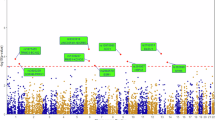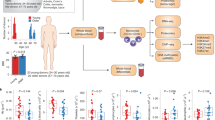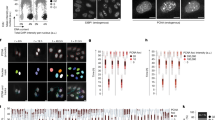Abstract
DNA-damage response and repair are crucial to maintain genetic stability, and are consequently considered central to aging and longevity. Here, we investigate whether this pathway overall associates to longevity, and whether specific sub-processes are more strongly associated with longevity than others. Data were applied on 592 SNPs from 77 genes involved in nine sub-processes: DNA-damage response, base excision repair (BER), nucleotide excision repair, mismatch repair, non-homologous end-joining, homologous recombinational repair (HRR), RecQ helicase activities (RECQ), telomere functioning and mitochondrial DNA processes. The study population was 1089 long-lived and 736 middle-aged Danes. A self-contained set-based test of all SNPs displayed association with longevity (P-value=9.9 × 10−5), supporting that the overall pathway could affect longevity. Investigation of the nine sub-processes using the competitive gene-set analysis by Wang et al indicated that BER, HRR and RECQ associated stronger with longevity than the respective remaining genes of the pathway (P-values=0.004–0.048). For HRR and RECQ, only one gene contributed to the significance, whereas for BER several genes contributed. These associations did, however, generally not pass correction for multiple testing. Still, these findings indicate that, of the entire pathway, variation in BER might influence longevity the most. These modest sized P-values were not replicated in a German sample. This might, though, be due to differences in genotyping procedures and investigated SNPs, potentially inducing differences in the coverage of gene regions. Specifically, five genes were not covered at all in the German data. Therefore, investigations in additional study populations are needed before final conclusion can be drawn.
Similar content being viewed by others
Log in or create a free account to read this content
Gain free access to this article, as well as selected content from this journal and more on nature.com
or
References
Herskind AM, McGue M, Holm NV, Sorensen TI, Harvald B, Vaupel JW : The heritability of human longevity: a population-based study of 2872 Danish twin pairs born 1870–1900. Hum Genet 1996; 97: 319–323.
Hjelmborg JVb, Iachine I, Skytthe A et al: Genetic influence on human lifespan and longevity. Hum Genet 2006; 119: 312–321.
Christensen K, Johnson TE, Vaupel JW : The quest for genetic determinants of human longevity: challenges and insights. Nat Rev Genet 2006; 7: 436–448.
Ciccia A, Elledge SJ : The DNA damage response: making it safe to play with knives. Mol Cell 2010; 40: 179–204.
Hiom K : Coping with DNA double strand breaks. DNA Repair (Amst) 2010; 9: 1256–1263.
Hoeijmakers JH : Genome maintenance mechanisms for preventing cancer. Nature 2001; 411: 366–374.
Jeppesen DK, Bohr VA, Stevnsner T : DNA repair deficiency in neurodegeneration. Prog Neurobiol 2011; 94: 166–200.
Bohr VA : Rising from the RecQ-age: the role of human RecQ helicases in genome maintenance. Trends Biochem Sci 2008; 33: 609–620.
Burtner CR, Kennedy BK : Progeria syndromes and ageing: what is the connection? Nat Rev Mol Cell Biol 2010; 11: 567–578.
Croteau DL, Singh DK, Hoh FL, Lu H, Bohr VA : RECQL4 in genomic instability and aging. Trends Genet 2012; 28: 624–631.
Blackburn EH, Greider CW, Szostak JW : Telomeres and telomerase: the path from maize, Tetrahymena and yeast to human cancer and aging. Nat Med 2006; 12: 1133–1138.
Campisi J, d’Adda de Fagagna F : Cellular senescence: when bad things happen to good cells. Nat Rev Mol Cell Biol 2007; 8: 729–740.
Lindsey J, McGill NI, Lindsey LA, Green DK, Cooke HJ : In vivo loss of telomeric repeats with age in humans. Mutat Res 1991; 256: 45–48.
Slagboom PE, Droog S, Boomsma DI : Genetic determination of telomere size in humans: a twin study of three age groups. Am J Hum Genet 1994; 55: 876–882.
Bakaysa SL, Mucci LA, Slagboom PE et al: Telomere length predicts survival independent of genetic influences. Aging Cell 2007; 6: 769–774.
Kimura M, Hjelmborg JV, Gardner JP et al: Telomere length and mortality: a study of leukocytes in elderly Danish twins. Am J Epidemiol 2008; 167: 799–806.
Njajou OT, Cawthon RM, Damcott CM et al: Telomere length is paternally inherited and is associated with parental lifespan. Proc Natl Acad Sci USA 2007; 104: 12135–12139.
Shay JW, Woodring WE : Telomeres and Telomerase in aging and cancer. Molecular Biology of Aging and Cancer, In: Guarente LP, Partridge L, Wallace DC (eds). Molecular Biology of Aging. Cold Spring Harbor Laboratory Press: New York, 2008; pp 575–597.
Barja G : Free radicals and aging. Trends Neurosci 2004; 27: 595–600.
Bohr VA, Anson RM : DNA damage, mutation and fine structure DNA repair in aging. Mutat Res 1995; 338: 25–34.
Kujoth GC, Bradshaw PC, Haroon S, Prolla TA : The role of mitochondrial DNA mutations in mammalian aging. PLoS Genet 2007; 3: e24.
Kirkwood TB, Austad SN : Why do we age? Nature 2000; 408: 233–238.
Kuningas M, Mooijaart SP, van HD, Zwaan BJ, Slagboom PE, Westendorp RG : Genes encoding longevity: from model organisms to humans. Aging Cell 2008; 7: 270–280.
Lindahl T : Instability and decay of the primary structure of DNA. Nature 1993; 362: 709–715.
Vijg J : Somatic mutations and aging: a re-evaluation. Mutat Res 2000; 447: 117–135.
Cabelof DC, Ikeno Y, Nyska A et al: Haploinsufficiency in DNA polymerase beta increases cancer risk with age and alters mortality rate. Cancer Res 2006; 66: 7460–7465.
Park PU, Defossez PA, Guarente L : Effects of mutations in DNA repair genes on formation of ribosomal DNA circles and life span in Saccharomyces cerevisiae. Mol Cell Biol 1999; 19: 3848–3856.
Tyner SD, Venkatachalam S, Choi J et al: p53 mutant mice that display early ageing-associated phenotypes. Nature 2002; 415: 45–53.
Castro E, Edland SD, Lee L et al: Polymorphisms at the Werner locus: II. 1074Leu/Phe, 1367Cys/Arg, longevity and atherosclerosis. Am J Med Genet 2000; 95: 374–380.
Kim DJ, Yi SM, Lee SY et al: Association between the MLH1 gene and longevity. Hum Genet 2006; 119: 353–354.
Schachter F, Faure-Delanef L, Guenot F et al: Genetic associations with human longevity at the APOE and ACE loci. Nat Genet 1994; 6: 29–32.
Willcox BJ, Donlon TA, He Q et al: FOXO3A genotype is strongly associated with human longevity. Proc Natl Acad Sci USA 2008; 105: 13987–13992.
Flachsbart F, Caliebe A, Kleindorp R et al: Association of FOXO3A variation with human longevity confirmed in German centenarians. Proc Natl Acad Sci USA 2009; 106: 2700–2705.
Soerensen M, Dato S, Christensen K et al: Replication of an association of variation in the FOXO3A gene with human longevity using both case-control and longitudinal data. Aging Cell 2010; 9: 1010–1017.
Manolio TA, Collins FS, Cox NJ et al: Finding the missing heritability of complex diseases. Nature 2009; 461: 747–753.
Deelen J, Uh HW, Monajemi R et al: Gene set analysis of GWAS data for human longevity highlights the relevance of the insulin/IGF-1 signaling and telomere maintenance pathways. Age (Dordr) 2013; 35: 235–249.
Wang K, Li M, Hakonarson H : Analysing biological pathways in genome-wide association studies. Nat Rev Genet 2010; 11: 843–854.
Wang L, Jia P, Wolfinger RD, Chen X, Zhao Z : Gene set analysis of genome-wide association studies: methodological issues and perspectives. Genomics 2011; 98: 1–8.
Wang K, Li M, Bucan M : Pathway-based approaches for analysis of genomewide association studies. Am J Hum Genet 2007; 81: 1278–1283.
Soerensen M, Dato S, Tan Q et al: Human longevity and variation in GH/IGF-1/insulin signaling, DNA damage signaling and repair and pro/antioxidant pathway genes: cross sectional and longitudinal studies. Exp Gerontol 2012; 47: 379–387.
Nybo H, Gaist D, Jeune B et al: The Danish 1905 cohort: a genetic-epidemiological nationwide survey. J Aging Health 2001; 13: 32–46.
Gaist D, Vaeth M, Tsiropoulos I et al: Risk of subarachnoid haemorrhage in first degree relatives of patients with subarachnoid haemorrhage: follow up study based on national registries in Denmark. BMJ 2000; 320: 141–145.
Nebel A, Kleindorp R, Caliebe A et al: A genome-wide association study confirms APOE at the major gene influencing survival in long-lived individuals. Mech Ageing Dev 2011; 132: 324–330.
R Development Core Team: R: A language and environment for statistical computing. R Foundation for Statistical Computing: Vienna, Austria, 2012.
Purcell S, Neale B, Todd-Brown K et al: PLINK: a toolset for whole-genome association and population-based linkage analysis. Am J Hum Genet 2007; 81: 559–575.
Goeman JJ, Buhlmann P : Analyzing gene expression data in terms of gene sets: methodological issues. Bioinformatics 2007; 23: 980–987.
Freidlin B, Zheng G, Li Z, Gastwirth JL : Trend tests for case-control studies of genetic markers: power, sample size and robustness. Hum Hered 2002; 53: 146–152.
de Souza-Pinto NC, Maynard S, Hashiguchi K et al: The recombination protein RAD52 cooperates with the excision repair protein OGG1 for the repair of oxidative lesions in mammalian cells. Mol Cell Biol 2009; 29: 4441–4454.
Harman D : The aging process: major risk factor for disease and death. Proc Natl Acad Sci USA 1991; 88: 5360–5363.
Lambert JC, Grenier-Boley B, Chouraki V et al: Implication of the immune system in Alzheimer’s disease: evidence from genome-wide pathway analysis. J Alzheimers Dis 2010; 20: 1107–1118.
Montesanto A, Latorre V, Giordano M, Martino C, Domma F, Passarino G : The genetic component of human longevity: analysis of the survival advantage of parents and siblings of Italian nonagenarians. Eur J Hum Genet 2011; 19: 882–886.
Jacobsen R, Martinussen T, Christiansen L et al: Increased effect of the ApoE gene on survival at advanced age in healthy and long-lived Danes: two nationwide cohort studies. Aging Cell 2010; 9: 1004–1009.
Di Bona D, Vasto S, Capurso C et al: Effect of interleukin-6 polymorphisms on human longevity: a systematic review and meta-analysis. Ageing Res. Rev 2009; 8: 36–42.
Acknowledgements
This study was supported by the Max-Planck Institute for Demographic Research, (Rostock, Germany), the INTERREG 4 A programme Syddanmark–Schleswig-K.E.R.N (by EU funds from the European Regional Development Fund), the European Union’s Seventh Framework Programme (FP7/2007–2011) under grant agreement no. 259679, the National Institute on Aging (P01 AG08761), the RESOLVE project (FP7-HEALTH-F4-2008-202047) and the Novo Nordisk, the Aase and Ejnar Danielsen, the Brødrene Hartmann, the King Christian the 10th and the Einer Willumsens Mindelegat Foundations. The Danish Aging Research Center is supported by a grant from the VELUX Foundation, while Mette Soerensen is supported by an individual postdoctoral grant from The Danish Council for Independent Research – Medical Sciences.
Author information
Authors and Affiliations
Corresponding authors
Ethics declarations
Competing interests
The authors declare no conflict of interest.
Additional information
Supplementary Information accompanies this paper on European Journal of Human Genetics website
Supplementary information
Rights and permissions
About this article
Cite this article
Debrabant, B., Soerensen, M., Flachsbart, F. et al. Human longevity and variation in DNA damage response and repair: study of the contribution of sub-processes using competitive gene-set analysis. Eur J Hum Genet 22, 1131–1136 (2014). https://doi.org/10.1038/ejhg.2013.299
Received:
Revised:
Accepted:
Published:
Issue date:
DOI: https://doi.org/10.1038/ejhg.2013.299
Keywords
This article is cited by
-
Mitochondria, its DNA and telomeres in ageing and human population
Biogerontology (2018)
-
Human longevity: Genetics or Lifestyle? It takes two to tango
Immunity & Ageing (2016)



